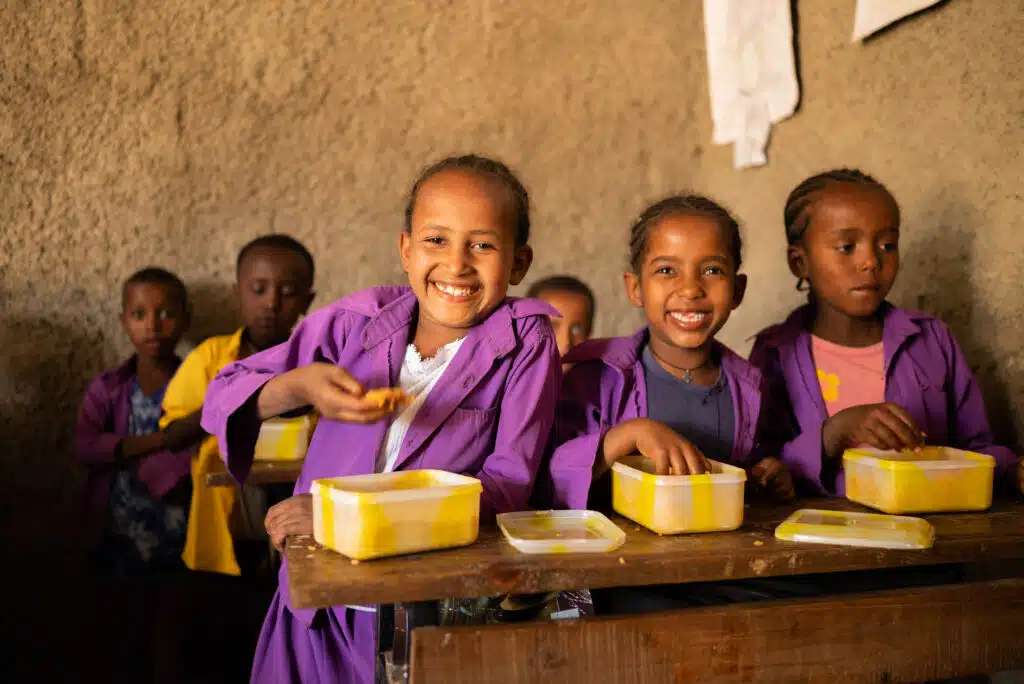Hunger is on the rise again for the first time in years. On World Food Day, I’m thinking of the communities hardest hit by the crisis and what I can do to help.
I’m sure I’m not alone in this, but when I think about how we’re going to tackle extreme hunger, I tend to focus on the short-term ways I can support instead of thinking about what caused such a crisis in the first place. The truth is that understanding the reason for extreme hunger is actually how we find a lasting, sustainable solution.
Compassion International recently broke down the crisis by answering six simple questions to a complex issue: who, what, when, where, why and how? Now, I am sharing that information so you can also better understand the crisis and steps we can take to combat hunger and poverty.
The following article was originally written by Compassion International and published on their website. It is reposted and edited with permission from the organization. To view the article directly, click here.
Where? The Hunger Crisis in Africa
Africa is home to over 1.4 billion people, hundreds of millions of whom live in extreme poverty. In fact, 27 of the world’s 30 poorest countries are in Africa.
Poverty in Africa is exacerbated by such factors as population density, gender inequality, war, political instability, economic shocks, class conflict, corruption, weather extremes and disease (e.g., AIDS, Ebola, and COVID-19). Because of these factors, Africans regularly deal with acute food shortages and food crises.
What? The Reality of Starvation in Africa: A Deeper Look
The term “starving African” often evokes painful images of children with distended bellies and skeletal bodies, their eyes begging for help. These images aren’t just stereotypes; they represent the grim reality for millions of people in Africa, particularly children. Despite the continent’s abundant natural resources and human potential, many people are still stuck in poverty, struggling to access food.
“Food insecurity in Africa” has become an unfortunate staple in global discussions about the continent. This term refers to how those in poverty can’t reliably access enough nutritious food, which would allow them to remain healthy and lead active lives. Food insecurity can lead to chronic malnutrition, and when combined with other factors such as disease, conflict and extreme poverty, it can escalate into a hunger crisis — a situation characterized by a severe and widespread lack of food and nutrition affecting a significant portion of a population and leading to serious humanitarian and health implications.
Who? How Many Africans Are Facing a Food Crisis?
Of the 10 countries identified by the World Food Programme (WFP) as having the highest number of people facing critical food insecurity in 2022, five are in Africa. In addition, the WFP reports that the number of people in Sub-saharan Africa facing critical food insecurity include:
- 45.5 million people in 12 countries in Central and Southern Africa.
- 43.6 million people in 9 countries in East Africa.
- 30.4 million people in 16 countries in West Africa and the Sahel.
When? A History of Hunger and Famine in Africa
- 1966 to 1967 — Biafran Famine: During Biafra’s secession war from Nigeria, a blockade was established by Nigeria. As many as 2 million civilians died from starvation caused by the stalemate. This famine was the first to be publicized by mass media in Western countries.
- 1970s to 1980s — The Sahel Drought: The Sahel is the transitional zone between the Sahara Desert and the humid savanna. A drought in the Sahel region from the late 1960s to the 1980s created poor grazing conditions for cattle, which resulted in famine. Over 1 million people starved in Mali, Chad, Niger, Mauritania and Burkina Faso.
- 1983 to 1985 — Ethiopia Famine: The 1980s Ethiopia famine was one of the worst humanitarian events of the 20th century. Recurring drought and failed harvests combined with civil war resulted in an estimated 1 million starvation deaths.
- 1991 to 1992 — Somalia Famine: Due to drought and civil war, many Somalis were unable to produce or receive food. The resulting famine took the lives of 350,000.
- 1998 to 2000 – Eritrean-Ethiopian War: A border war between Ethiopia and Eritrea killed or wounded many citizens and used precious economic resources. The war’s destruction combined with three consecutive years of drought led to the loss of livestock, population displacement and malnutrition. An estimated 10 million persons were placed at risk of starvation.
- 1998 to 2003 — The Second Congo War: Known as Africa’s World War, the Second Congo War was the widest interstate war in modern African history. Nearly 4 million Africans died during the conflict, mainly from starvation and disease.
- 2005 to 2006 — Niger Food Crisis: In 2004 a severe drought and locust invasion destroyed up to 100% of the crop in regions of Niger. More than 3 million people were left short of food, and many became malnourished and vulnerable to disease.
- 2011 to 2012 — East Africa Famine: A severe drought across East Africa caused the famine in Somalia, Djibouti, Ethiopia, Kenya, Uganda and other neighboring countries, resulting in an estimated 285,000 deaths.
- 2015 to 2016 — El Niño Drought: One of the strongest El Niños on record created a severe drought in southern and eastern Africa. The drought damaged crops, causing food insecurity for more than 50 million people.
- 2020 — COVID-19 Lockdowns: During COVID-19 lockdowns, many laborers lost their means of income. Additionally, the response time to humanitarian crises, such as locust invasions, was slowed. As a result, the ranks of Africans in extreme poverty have surged, as have the rates of acute malnutrition.
- 2021 to 2022 — Rising Global Food Crisis: Launched by the economic impacts of the pandemic, an unprecedented global food crisis has been fueled by a number of situations, including inflation, supply shortages, weather extremes, war in Ukraine, and regional conflict.
Why? What Are the Causes of Hunger in Africa?
According to the World Food Programme, the primary causes of the current global food crisis, which is affecting Africa more than any other region, are threefold:
- Economic Shocks: For many Africans already struggling to survive on a meager income, the COVID-19 pandemic and resulting movement restrictions severely affected their ability to work. Without any savings and unable to leave the house to work for a daily wage meant sacrificing daily necessities, including food. Livelihoods collapsed, and Africans are now struggling to survive while seeking a sustainable source of income.
In addition, soaring food prices have made it even more difficult for families in extreme poverty to afford the nutrition they need. And Russia’s war in Ukraine has disrupted critical shipments of wheat, cooking oil and fertilizer supplies that Africa is heavily dependent on.
- Conflict/Insecurity: Between 2018 and 2021, the number of people facing severe food insecurity in countries experiencing conflict/insecurity increased by a staggering 88%.
Countries experiencing conflict/insecurity include Ethiopia and Burkina Faso, two of the African countries in which Compassion partners with local churches to assist children and families in extreme need.
Conflict leads to loss of local food resources, as crops and livestock are plundered or destroyed. It also leads to the displacement of people fleeing the conflict, often ending up in camps for refugees or internally displaced persons (IDPs) reliant on the international community for food assistance.
- Weather Extremes: Increasing weather-related natural disasters, are destroying agricultural production. In east, central and southern Africa, ongoing drought and intermittent flooding during rainy seasons have been devastating for impoverished families reliant on small-scale, agriculture-based efforts.
How? How Is Compassion Fighting the Global Food Crisis in Africa?
The current forecasts about the global food crisis indicate that the African children and families in Compassion’s care will experience critical, widespread need for nutrition interventions in both the near and long terms.
- Hunger Interventions for the Near Term
For families with low household food security, Compassion provides packages of food and/or direct cash transfers to address immediate hunger needs.
Mobile money transfers provide cash directly to families in a secure, discreet and cost-effective way. Families can then use the money to obtain food.
- Hunger Interventions for the Long Term
Long-term, sustainable food access is Compassion’s ultimate goal for the families we serve. In rural areas, families are provided agricultural inputs (seeds, fertilizer, livestock, etc.) and training on how to increase harvests through small family farming efforts.
In urban areas children and caregivers receive training in income-generation activities and opportunities to earn a sustainable living that covers their nutrition needs.
Your Opportunity to Make a Difference in Africa
We invite you to join other caring Compassion International supporters and workplace givers to help address life-threatening hunger needs in Africa caused by the current global food crisis. You can play a vital part in this collective effort by making a gift through your workplace giving program. Your pledge could provide immediate food aid to an African child or family who is starving, equip a farmer with the resources he needs or support a community as they build self-sufficiency to combat food insecurity.




